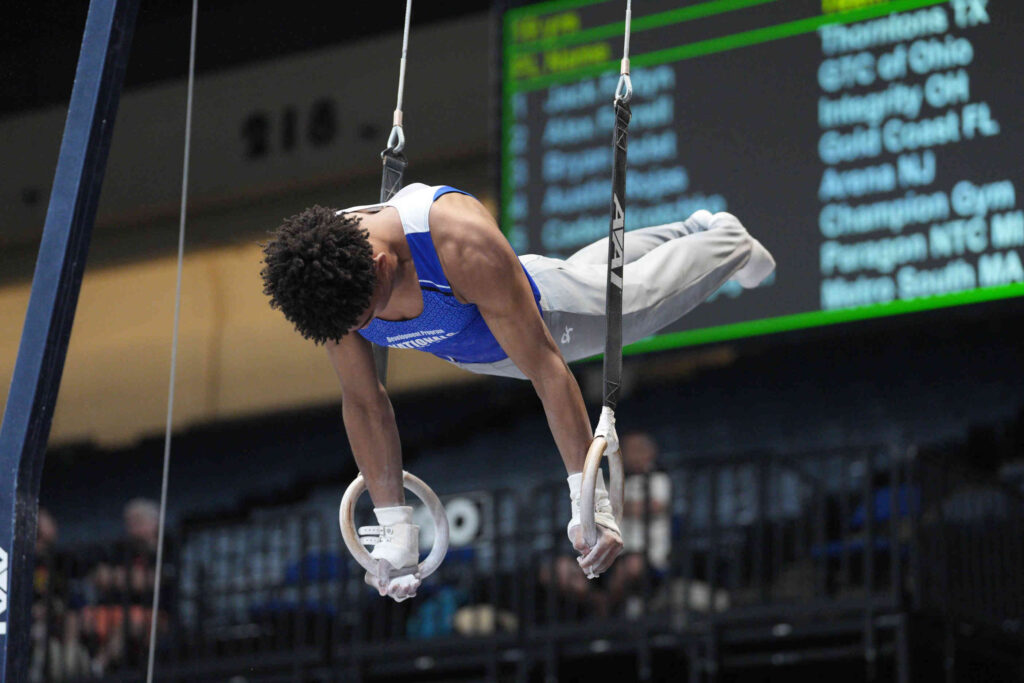The third event in the men’s gymnastics Olympic order, the Still Rings symbolizes strength and poise. Strength holds such as the iron cross iconically represent the might required to be a great gymnast on the Rings. Indeed, a gymnast must be one of the pound-for-pound strongest athletes on earth in order to be the “Lord of the Still Rings”.
But how exactly do judges determine whose still rings performance is best? In this third part of our guides to the events of men’s gymnastics, we will breakdown the structure of a Rings routine to help you understand how the event works.
What Are the Still Rings?
The Still Rings themselves are two rings suspended from straps and attached to a metal frame.
The still rings have been a staple of Olympic gymnastics since the modern Games began in 1896, highlighting their historical significance and the high level of skill required to perform on them.
Key Characteristics of Still Rings Performances
Again, Still Rings exemplifies strength, and has a focus on holding challenging positions as still as possible.
A Still Rings routine combines swinging movements, strength elements, and static holds in roughly equal parts. Gymnasts perform skills while hanging, supporting on top of the rings, and through handstand. Smooth transitions between dynamic swings and static strength moves characterize modern routines , with a large emphasis on maintaining straight arms throughout the whole routine.
Quick Review of Scoring – How Judges Score Still Rings?
How Judges Score Gymnastics Routines in a Nutshell.
The difficulty score, or D-Score, indicates the difficulty of the routine the gymnast performed.
D-Score = letter values assigned to the skills in a routine + value from element groups fulfilled + any bonuses
The execution score, or E-Score, indicates how well the gymnast executed the routine.
E-Score = 10.0 – sum of all deductions in a routine.
Final Score = D-Score + E-Score
Judges score Men’s Artistic Gymnastic routines with a difficulty score and execution score, known as the D-Score and E-Score.
D-Score: Evaluating Difficulty on Still Rings
In a Men’s Gymnastics routine, the eight highest-difficulty skills a gymnast performs in his routine count toward the D-Score.
The FIG code of points assigns a letter value to each skill indicating its how difficult it was. Each letter corresponds to a point value, as noted in the chart below.

Additionally, athletes earn difficulty for including skills from different categories, called element groups, defined in the code of points. Most events, including still rings, feature three main element groups plus a dismount group. Each element group serves a specific purpose in showcasing the gymnast’s abilities on the apparatus.
For judges to award value for element groups, gymnasts need to include skills from these element groups in their routines. Including a D-value skill or higher from an element group grants fulfillment for that group and awards 0.5 to the gymnast’s Difficulty Score. Interestingly, gymnasts can also receive partial credit of 0.3 by performing an A, B, or C-value skill within an element group.
The dismount, which concludes the routine, has its own scoring nuance. The value awarded for the dismount element group matches the difficulty value of the dismount itself. For instance, if a gymnast performs an E-value dismount, they would receive 0.5 points for the skill’s difficulty and an additional 0.5 points for fulfilling the dismount element group.
This scoring system encourages gymnasts to create well-rounded routines that demonstrate a variety of skills while also rewarding those who can execute more difficult elements, particularly in their dismounts.
What Are the Element Groups on Still Rings?
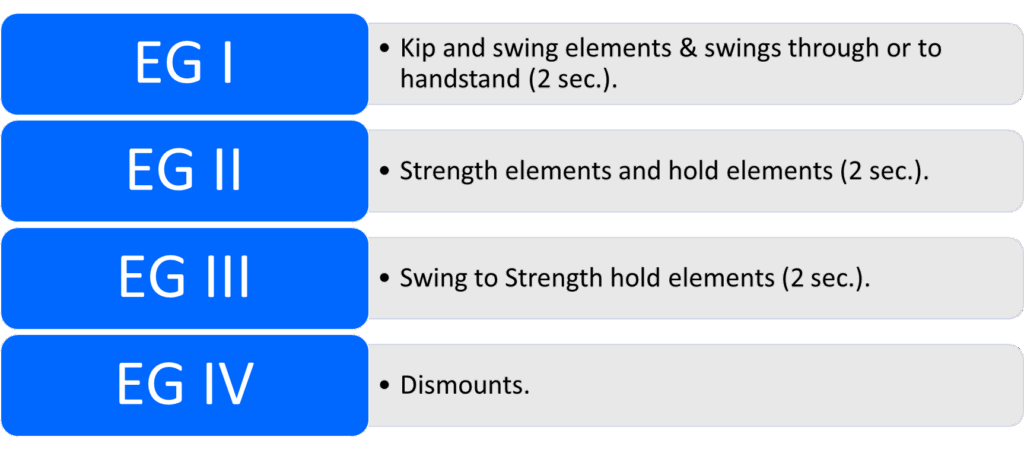
Element Groups In-Depth: Which Skills Fit in Each Element Group?
EG I – Kip and swing elements & swings through or to handstand
Elements in EGI swing through hang or support on the rings without stopping in any final position, except for handstand.
The most foundational swinging skills are the dislocate (A) and inlocate (A). A dislocate is a swing forward that continues up and over the rings back into another swing forward. An inlocate is a swing backward that continues up and over the rings back into another swing backward.
Inlocates and dislocates lead into more difficult swinging skills like a front or back giant. A back giant (C) is a swing forward that finishes in a handstand, while a front giant (C) is a swing backward that finishes in a handstand. Giant swings that pass through a handstand but don’t stop award a B value.
Uprises are swings forward or backward from hang into support on top of the rings. These are most commonly done by juniors and they are only worth an A.
Salto Swings – Honma, Yamawaki, and Friends
Very distinct from other swinging skills, the salto swings look like double somersaulting skills where the gymnast holds on to the rings the whole time. Most notable are the Yamawaki (B), a tucked double salto forward to hang, and Jonasson (C), a piked or stretched double salto forward to hang. These are extremely frequent at the upper levels of junior competition and nearly ubiquitous in elite rings performance.
When a yamawaki finishes in support, it is called a Honma (B).
More rare are the backward double saltos, mostly because of the extreme stress they put on the shoulder. Here we have the double tucked salto backward, called a Guczoghy (C), and its piked variant (D).
*** With the Yamawaki (C->B) and Jonasson (D->C) downgraded moving into the 2025-2028 code of points, the backward saltos may become more common. Keep an eye on this. ***
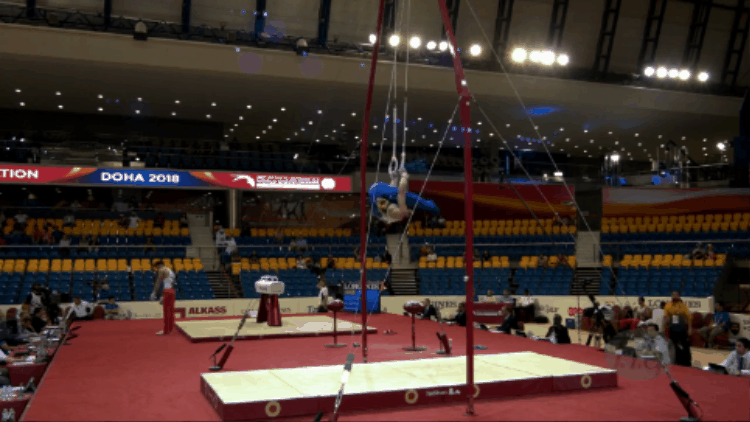
EG II – Strength and Hold
The simplest strength skill on ring is the L-sit hold (A), which will show up in most junior gymnasts routines. Progressing from the L-sit, you have the V-sit hold (B). Unfortunately, no one has yet to perform a Manna on the rings.
The most recognizable strength skill is the iron cross (C), also known as the crucifix. This position involves the arms straight out horizontally to the sides, shoulders in line with the rings, with the feet and legs pointed straight down. Variations include the L-Cross as well as V-Cross, which involve performing an L or V Hold while in a cross.
Another set of skills are the various planches. In a straight planche (C), a gymnast leans forward in support on top of the rings to hold their body level with the floor. Gymnasts can perform a straddle planche (A) as well.
A similar skill, the maltese (D), is just like a planche except the body will be in line with the rings rather than in support. A maltese is also referred to as a swallow or hirondelle.
The reverse of a maltese, known as a victorian or inverted swallow (E), involves leaning backward with the hips facing up coming to level in line with the rings.
Lastly, we have an inverted cross (D), a handstand with the arms straight out horizontal to the sides with the shoulders in line with the rings. Again, this is exactly like an iron cross, but the feet point up instead of down.
Upgrading Strength Holds
From the basic building block strength skills, a gymnast can increase the difficulty in a few different ways. Generally, a modification to how a gymnast enters a skill or transitioning directly between strength elements creates a more difficult skill.
For example, we have slow forward or backward roll entries into holds, such as the Azarian (D), a slow backward roll into an iron cross.
Likewise, gymnasts will exit their strength skill into a back lever, and then transition into their next strength skill. This is seen with a Nakyama (E), a back lever press up to cross.
Exiting a hold with a press out to another strength element rewards extra value as well, such as an iron cross pull out to L-sit (C).
Furthermore, there are butterfly-style skills that involve a pull from a vertical long hang. Notable here are the Balandin family of skills:
– Balandin 1 (F): Vertical Pull to Maltese
– Balandin 2 (G): Vertical Pull to Inverted Cross
– Balandin 3 (E): Vertical Pull to Planche
These in no way encompass every skill listed in the code of points, and there are a tremendous number of variations of skills listed here. Elite gymnasts have numerous ways to express their strength.
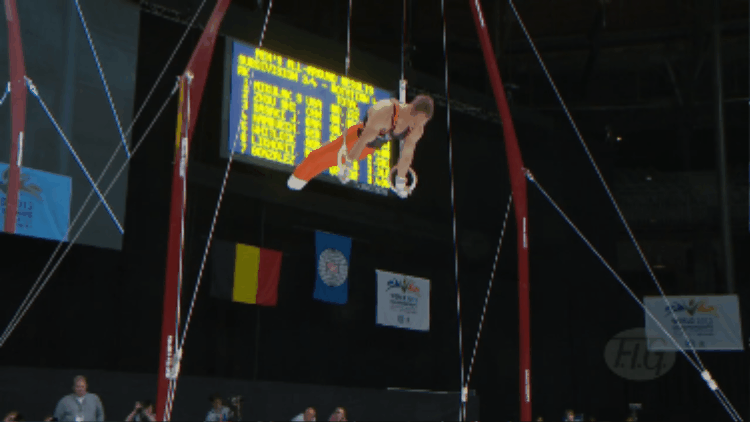
EG III – Swing to Strength
The third element group combines skills from EG I finishing in a skill from EG II. Again, swing to strength skills are a kip or swing element finishing in a strength and hold element.
You can have a back uprise or front uprise that finishes in various strength positions, like the back uprise cross (C) or back uprise maltese (D).
Similarly, you can see a kip or back kip to strength elements. Uniquely, a kip to V-cross, or Molinari, is a D value.
The Honma to cross (D) is another frequently performed swing to strength at the senior level.
More rarely you will see a felge to a strength element.
Most commonly performed by juniors in the USA dev program is a kip to L (B) or front uprise to L (B), as these are the simplest to perform for value. A back uprise to straddle planche (B) is another frequently performed skill for juniors.

EG IV – Dismounts
In elite gymnastics competitions, gymnasts perform backward dismounts most often. The most frequently performed dismounts include:
– double tuck with 2/1 twist (E)
– double layout with 2/1 twist (F)
– double layout with 1/1 twist (D)
Still Rings Execution and Common Deductions
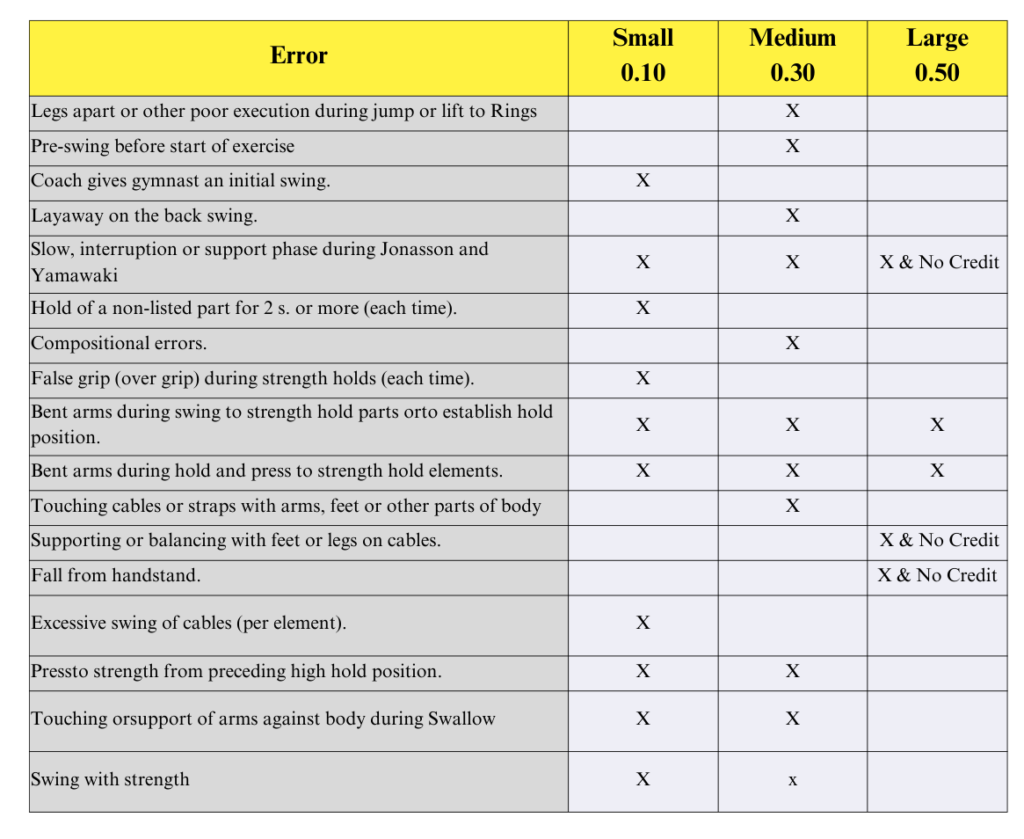
STILL Rings: Deductions for Moving Holds or Bad Positions
The code of points really emphasizes the Still in Still Rings. Many deductions focus on a gymnasts ability to hold a static position, or limit the movement of the rings:
– The code states that each hold position must be held for a minimum of 2 seconds, and counting does not start until the gymnasts comes to a still position.
– During swing to strength, the body cannot rise more than 5 degrees above the ideal hold position without accruing deduction… greater than 45 degrees and the gymnasts loses credit and 0.5.
– In swing to handstand elements or swing to strength elements, lowering of the legs from the stopping point also accrues similar deductions.
– Any time the gymnast comes to a static hold, the rings should sway as little as possible. Excessive rings sway gets 0.1 deduction for each element.
Rhythm and Swing Breaks
In contrast, some deductions rely on maintaining the rhythm of swing throughout certain skills.
– Transitions between strength elements in EG II need to be slow and controlled to avoid deduction, or being accidentally recognized as a swing to strength.
– Jonasson/Yamawaki style skills must not show a recognizable support phase on top of the rings, and should maintain rhythm throughout the whole swing. Support on the rings gets a 0.5 deduction and no recognition for the skill, with small, medium, and large deductions for rhythm breaks.
Finally, a few subtle deductions exist that many might not easily catch.
– If a gymnast does not perform a swing to handstand, 0.3 is deducted from the routine. So, for example, a gymnast can still receive credit for EGI by performing a yamawaki, but lose 0.3 by missing a swing to handstand.
– Holding non-listed parts, such as an inverted hang, long hang, or support, for more than 2 seconds is 0.1 deduction for each occurrence.

